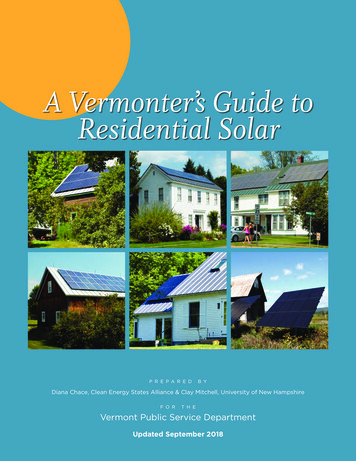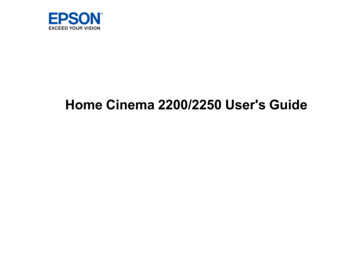
Transcription
A Vermonter’s Guide toResidential SolarP r e pa r e db yDiana Chace, Clean Energy States Alliance & Clay Mitchell, University of New Hampshiref o rt h eVermont Public Service DepartmentUpdated September 2018A Vermonter’s Guide to Residential Solar1
AcknowledgementsThis guide was first released in September 2016 and produced by the Clean Energy StatesAlliance (CESA) and the Vermont Public Service Department’s Clean Energy DevelopmentFund through the New England Solar Cost-Reduction Partnership, a Rooftop Solar Challenge II project. The New England Solar Cost-Reduction Partnership worked to reduce thecosts of solar deployment across five New England states by targeting non-hardware solar“soft” costs. Diana Chace of CESA and Clay Mitchell of The University of New Hampshirewrote the guide. Nate Hausman of CESA was lead editor of the report. Ed Delhagen, AnneMargolis, and Andrew Perchlik of the Vermont Public Service Department; Leigh Seddonof L.W. Seddon, LLC; Johanna Miller of the Vermont Natural Resources Council; KenJones of the Vermont Agency of Commerce & Community Development; Olivia CampbellAndersen of Renewable Energy Vermont; and Warren Leon and Maria Blais Costello ofCESA reviewed the report.About the Vermont Public ServiceDepartment Clean Energy Development Fund (CEDF)The CEDF, at the Vermont Public ServiceDeparment (PSD), offers a portfolio of funding opportunities to accelerate the developmentand production of renewable energy in Vermont including: grants, direct incentive payments,credit enhancements for renewable energy lenders, contracts for specific products or services,and other offerings as may be authorized by the Vermont General Assembly and subject toapproval of the PSD. Since its inception, the CEDF has awarded over 64 million in federaland state resources for renewable energy and energy efficiency in Vermont, leveraging totalinvestments of more than 258 million in the state’s clean energy infrastructure. Learnmore at http://publicservice.vermont.gov/renewable energy/cedf.About Clean Energy States AllianceClean Energy States Alliance (CESA) is anational, nonprofit coalition of public agenciesand organizations working together to advance clean energy. CESA members—mostly stateagencies—include many of the most innovative, successful, and influential public fundersof clean energy initiatives in the country. CESA works with state leaders, federal agencies,industry representatives, and other stakeholders to develop and promote clean energy technologies and markets. It supports effective state and local policies, programs, and innovation in the clean energy sector, with an emphasis on renewable energy, power generation,financing strategies, and economic development. CESA facilitates information sharing,provides technical assistance, coordinates multi-state collaborative projects, and communicates the achievements of its members. Learn more at www.cesa.org.About the Solar EnergyTechnologies OfficeThe U.S. Department of Energy Solar EnergyTechnologies Office supports early-stage research and development to improve the reliabilityand performance of solar technologies. Learn more at energy.gov/solar-office.2V e r m o n t P u b l i c S e r v i c e d e pa r t m e n tDisclaimersThis material is based upon worksupported by the U.S. Departmentof Energy under Award NumberDE-EE0006305. This report wasprepared as an account of worksponsored by an agency of the UnitedStates Government. Neither theUnited States Government nor anyagency thereof, nor any of theiremployees, makes any warranty,express or implied, or assumes anylegal liability or responsibility for theaccuracy, completeness, or usefulnessof any information, apparatus, product,or process disclosed, or representsthat its use would not infringeprivately owned rights. Referenceherein to any specific commercialproduct, process, or service by tradename, trademark, manufacturer,or otherwise does not necessarilyconstitute or imply its endorsement,recommendation, or favoring by theUnited States Government or anyagency thereof. The views and opinions of authors expressed herein donot necessarily state or reflect thoseof the United States Governmentor any agency thereof. This report isfor informational purposes only anddoes not constitute legal, financial,or technical advice from the U.S.Department of Energy, the VermontPublic Service Department, CESA,or other contributors.
Table of ContentsHow to Use This Guide.510 Key Things to Remember if You’re Thinking about Solar.6Section 1: Reasons Vermonters Choose to Go Solar.8Financial. 8Environmental. 8Local Economic Development. 9Community. 9Energy Independence and Resilience. 9Section 2: What Is a Solar PV System?. 10The Solar Cell and Panel.10Racking and Including Storage—On-grid and Off-grid Options.15Solar Photovoltaics vs. Solar Thermal.15Section 3: Is a PV System Right for You?. 16Your Goals.16Efficiency.16Renter or Owner.16Electric Bill.16Roofing Material, Roof Age, and Roof Condition.17Orientation, Tilt, and Shading.17Neighborhood Concerns.18Group Net Metering (Off-site Solar).18What Happens with Your Solar Panels if You Move to a New Home?.19Online Solar Calculators.20Section 4: Financing Your Solar PV System.211. Direct Ownership.21Secured vs. Unsecured.21Market Rate vs. Credit Enhanced.212. Third-Party Ownership.21Lease.21Net Metering Credit Purchase Agreements.22Contract Provisions: Leases and Net Metering Credit Purchase Agreements.22Fixture Filings.23Upfront Lease Payment Option.24Sample Language.24A Vermonter’s Guide to Residential Solar3
Section 5: How Solar Can Save You Money. 25Federal Tax Credit.25Renewable Energy Certificates (RECs).25Net Metering.26Vermont Property Tax and Vermont Sales Tax.27Section 6: Choosing a Contractor. 28Where to Look?.28Qualifications.28Where to Check for Complaints.28Get Multiple Bids.28What Bids Should Include.29Comparing Bids.30Signing a Contract.30Section 7: Permitting. 33Municipal Permits.33Certificate of Public Good (CPG).33Section 8: After the System is Installed. 35System Maintenance.35Cleaning.35Monitoring Your System.36System Safety.38Insurance.38Warranties.38Meters.40How to Address a Problem with a Solar Company.40Panel Removal.40Appendix 1: Net Metering (Updated August 2018). 41The Basics: How Net Metering Works.41How Net Metering Credits Accumulate Over Time.42Non-bypassable Charges .42Changes in Compensation Rates Over Time.43Siting Adjusters for Group Net Metering .43Appendix 2: Questions to Ask a Solar Contractor. 44Additional Questions for a System with a Lease or Net Metering Credit Purchase Agreement.44Additional Questions that Only Apply to a Group Net-Metered System.45Appendix 3: PV Project Checklist. 46Appendix 4: Resources. 48Official Information on Net Metering in Vermont.48Vermont Organizations.48Other Resources.48Appendix 5: Glossary. 494V e r m o n t P u b l i c S e r v i c e d e pa r t m e n t
How to use this GuideThere are many ways to build and finance a solar PV system.A Vermonter’s Guide to Residential Solar can help you decidewhether it makes sense for you to go solar and, if so, how.You do not necessarily have to read the guide from coverto cover, or all at once. It is divided into sections so that youcan refer to relevant information at different points in thedecision making and installation process. Although thereis a lot to consider, keep in mind that hundreds of thousandsof Americans who are not energy experts have happily andsuccessfully installed solar on their homes or invested ingroup solar projects.The guide provides information in the following sections:S ection 1 :Reasons Vermonters are choosing solarS ection 2 :The physical components of a PV systemConsumer needs, opportunities, and systemdesign considerationsS ection 3 :S ection 4 :Ways to finance a solar systemSolar savings and incentives, including thefederal tax credit, net metering, and RenewableEnergy Certificates (RECs)S ection 5 :S ection 6 :Choosing a solar contractor and reviewinga solar contractS ection 7 :Solar system permittingS ection 8 :After your system is installedIt also includes several appendices that cover: Net Metering (Updated August 2018) Questions to Ask a Solar Contractor PV Project Checklist Resources GlossarySolar panels are a big investment, whether you buy themoutright or finance them over decades. Take some timeto learn about solar and solar financing, so you can beconfident that your investment is a good one.AA VVeerrmmoonntteerr’’ss GGuuiiddee ttoo RReessiiddeennttiiaall SSoollaarr 55
10 Key Thingsto RememberIf You’re Thinking about Solar1. Solar is a significant investment.Deciding to “go solar” is comparable to buying a car or making other major homeimprovements. Make sure you think it through carefully.2. Consider energy efficiency.If your home is not already highly energy efficient, you can do even more good—for your wallet and for the environment—by including efficiencywith solar. See “Efficiency” on p. 16.3. Financing options are available.There are four main ways to pay for a solar system, each with its own advantagesand disadvantages. See “Financing Your Solar PV System” on p. 21. Paying cash up front Financing a system through a loan Signing a solar lease Signing a net metering credit purchase agreement4. Net metering is key.Through net metering, utility customers who generate their own power can feedelectricity produced back into the electricity grid and get credit for that power.Net metering figures into the calculations for solar savings and solar financing.See “Net Metering” on p. 26.6V e r m o n t P u b l i c S e r v i c e d e pa r t m e n t
5. Group net metering is possible.Perhaps you don’t own your own home or there isn’t a viable location on yourproperty for solar; there may still be a solar option for you. A renter or a homeownercan participate in a group net-metering project, an offsite solar array that servesmultiple customers. See “Group Net Metering” on p. 18.6. Federal incentives are available.The federal government provides an investment tax credit (ITC) that is worth30 percent of the total cost of a residential solar system for those who are eligible.See “Federal Tax Credit” on p. 25.7. Several contractor bids are better than one.Consider proposals or bids from at least three different solar contractors to helpselect the best solar installer for you. See “Choosing a Contractor” on p. 28.8. Calculate the financial deal.Before selecting a bid and signing a solar contract, calculate your net savings,return on investment, and/or payback period. See “Comparing Bids” on p. 30.9. Understand the impact of changing utility rates.In any calculation of how much money your solar system can save you, assumptionsabout future utility rate increases are very important. Make sure that you and yourcontractor are calculating future electricity costs appropriately. See “UnderstandingUtility Rate Increase Impacts” on page 30.10. Know what you are signing.Make sure you have read and fully understand your solar contract before you signit. See “Contract Provisions” on p. 22 as well as “Signing a Contract” on p. 30.A Vermonter’s Guide to Residential Solar7
S e c t i o n 1Reasons Vermonters Choose to Go SolarThere are many good reasons to go solar. The price of solar PV systems has come down significantly in recent years, the technology has proven to be reliable, and there are more ways to payfor it. Below are several key reasons why Vermonters have decided to get their electricity fromrenewable solar resources.FinancialMany Vermonters have been able to save money with solar panels. The cost of panels has fallendramatically over the past decade. Net metering allows customers to get credit from their utilitiesfor electricity generated by their panels. Innovative financing options, including leases and netmetering credit purchase agreement,1 enable consumers to pay for solar panels with a monthlycharge spread out over many years rather than upfront in a lump sum. Many solar consumers’ totalelectricity costs, even accounting for the cost of the panels, are reduced after installing solar panels.EnvironmentalMost of the electricity produced in New England comes from burning fossil fuels, mainly naturalgas. This produces emissions that contribute to air pollution, including carbon dioxide, whichcauses global warming. Solar panels have no emissions and can reduce the need for fossils fuels. CESA/Blais Costello1 A Note on Terminology: A net metering credit purchase agreement is an arrangement in which a third party owns a solarsystem and a customer receives credit from the utility for the electricity the solar panels generate. This arrangement isoften referred to as a power purchase agreement (PPA) in other states.8V e r m o n t P u b l i c S e r v i c e d e pa r t m e n t
Local Economic DevelopmentSolar installations in Vermont give rise to solar jobs in Vermont. According to the VermontClean Energy Industry report, more than 2,100 Vermonters were employed in the solar electricgeneration sector in 2016, and solar employment was 13 percent higher than in 2015.2 Installingsolar panels helps to sustain these jobs and to expandthis sector of Vermont’s economy.Solar can help bring peopletogetheraround a common goal or project.CommunitySolar can help bring people together around a comMany Vermont cities and towns havemon goal or project. Some Vermont municipalitieshave adopted specific energy targets and have bandedstarted municipal energy committeestogether to help achieve them. Many Vermont citiesand towns have started municipal energy committeesto help transition toward cleanto help transition toward clean energy at the localenergy at the local level.level. In some cases, people have united around specific group net-metering projects or been broughttogether through “Solarize,” a community-focused solar group purchasing campaign. The structureof Solarize, with volunteer-driven outreach and increasing discounts as more people sign up to gosolar, encourages peer-to-peer interaction and community building.Energy Independence and ResilienceSome Vermonters choose solar because they want to be more independent and produce theirown power. To be completely independent of the grid requires investing in a stand-alone energysystem and installing battery storage. Most people who go solar don’t choose an off-grid system.A grid-tied system will not function in the case of an electricity outage unless the home has anaccompanying electricity storage system and the ability to “island” (disconnect from the grid).(See p. 15 for more discussion of these options.) But even a simple grid-connected system stillprovides some independence in the sense of being insulated from utility rate fluctuations andproducing a portion of the power used.2 Vermont Clean Energy Industry Report, ocuments/Renewable Energy/CEDF/Reports/VCEIR%202016%20Final.pdf.A Vermonter’s Guide to Residential Solar9
S e c t i o n 2What Is a Solar PV System?Photovoltaic (PV) systems convert sunlight into electricity. Sunlight strikes the panel materialand frees electrons, and electricity is created. (See Figure 1.)The electricity produced in a PV system is direct current (DC). Other than some off-grid homesand specialized appliances, homes use alternating current (AC). The PV system changes the DCinto AC, through the use of an inverter. The AC power from the inverter is then connected tothe home’s electrical system so that the electricity produced by your array can power your home.PV systems have few moving parts and are generally very reliable and require little maintenance.Understanding the components of a PV system can help in deciding whether to go solar, and how.The Solar Cell and PanelThe basic electricity producing structure is the solar cell, which is comprised of silicon andelectrodes. Cells are strung together in a panel (also referred to as a module). A series of panelsconnected together electrically and fed into the inverter is known as a string. The term often usedto refer to all the panels in a system is an array. The output of a panel is measured in DC-watts.The nameplate output of a panel represents the amount of power produced in optimal conditions.Modern full-sized panels can reach up to 350 watts per panel and can be comprised of 80 cellsworking together. These panels are usually rectangular or square and measure around 20 squarefeet for the 350 watt panels. Lower output panels have fewer cells and come in smaller sizes.Choice of panel size, output and shape will usually depend on the installation method andF igure 1How a PV System WorksMeterSource: LetsGoSolar.com10V e r m o n t P u b l i c S e r v i c e d e pa r t m e n tMeter
F igure 2Traditional Rooftop Mounting SystemSource: LetsGoSolar.comlocation. It could also depend on other factors, as Vermont solar vendors offer different typesof panels. There are different ranges of power output and efficiency depending on the brand ofthe solar panels.Racking and MountingRacking and mounting systems secure solar panels together and attach them to the structure orto the ground, usually as part of the system’s electrical grounding. (See Figure 2.) Proper groundingis required by electric codes and ensures safe operation. Since most panels are warrantied to last25 years and will likely last longer, it is good to have quality racking that can last at least as longwithout corrosion or other degradation, and can withstand wind, ice, and snow loads.Racking is comprised of several parts. Panels are clipped to the racking rails (primarilyaluminum), and the rails in turn are secured to mounting units. These units secure the systemto the support structure (either a roof, pole or the ground). The racking can also provide channelsfor wiring, offering protection and aesthetic benefits for the system. Some racking is availablein different colors to match roofing and panel composition (such as silver and black).In a roof-mounted system, the mounts are usually secured to underlying rafters and includemultiple layers of water-proofing and flashing to protect the roof from water damage and leaking.Mounting is a critical component to protect the roof and ensure the long-term viability of thesystem an
successfully installed solar on their homes or invested in group solar projects. the guide provides information in the following sections: SECTION 1:r easons Vermonters are choosing solar SECTION 2:ysical components of a PV system the ph SECTION 3: Consumer needs, opportunities, and system design considerations










